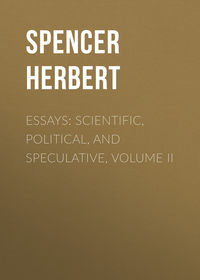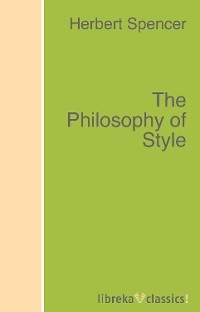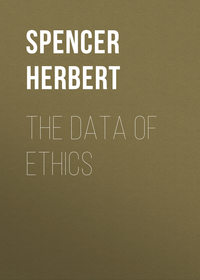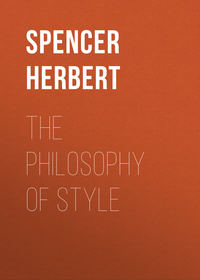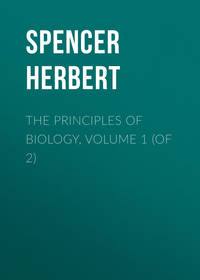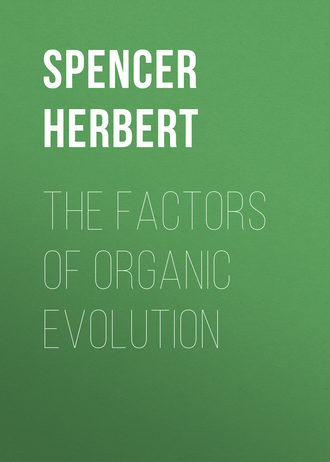 полная версия
полная версияThe Factors of Organic Evolution
Now without saying that acceptance of this group of propositions is impossible, we may certainly say that it is not easy.
“But where are the direct proofs that inheritance of functionally-produced modifications takes place?” is a question which will be put by those who have committed themselves to the current exclusive interpretation. “Grant that there are difficulties; still, before the transmitted effects of use and disuse can be legitimately assigned in explanation of them, we must have good evidence that the effects of use and disuse are transmitted.”
Before dealing directly with this demurrer, let me deal with it indirectly, by pointing out that the lack of recognized evidence may be accounted for without assuming that there is not plenty of it. Inattention and reluctant attention lead to the ignoring of facts which really exist in abundance; as is well illustrated in the case of pre-historic implements. Biassed by the current belief that no traces of man were to be found on the Earth's surface, save in certain superficial formations of very recent date, geologists and anthropologists not only neglected to seek such traces, but for a long time continued to pooh-pooh those who said they had found them. When M. Boucher de Perthes at length succeeded in drawing the eyes of scientific men to the flint implements discovered by him in the quarternary deposits of the Somme valley; and when geologists and anthropologists had thus been convinced that evidences of human existence were to be found in formations of considerable age, and thereafter began to search for them; they found plenty of them all over the world. Or again, to take an instance closely germane to the matter, we may recall the fact that the contemptuous attitude towards the hypothesis of organic evolution which naturalists in general maintained before the publication of Mr. Darwin's work, prevented them from seeing the multitudinous facts by which it is supported. Similarly, it is very possible that their alienation from the belief that there is a transmission of those changes of structure which are produced by changes of action, makes naturalists slight the evidence which supports that belief and refuse to occupy themselves in seeking further evidence.
If it be asked how it happens that there have been recorded multitudinous instances of variations fortuitously arising and re-appearing in offspring, while there have not been recorded instances of the transmission of changes functionally produced, there are three replies. The first is that changes of the one class are many of them conspicuous, while those of the other class are nearly all inconspicuous. If a child is born with six fingers, the anomaly is not simply obvious but so startling as to attract much notice; and if this child, growing up, has six-fingered descendants, everybody in the locality hears of it. A pigeon with specially-coloured feathers, or one distinguished by a broadened and upraised tail, or by a protuberance of the neck, draws attention by its oddness; and if in its young the trait is repeated, occasionally with increase, the fact is remarked, and there follows the thought of establishing the peculiarity by selection. A lamb disabled from leaping by the shortness of its legs, could not fail to be observed; and the fact that its offspring were similarly short-legged, and had a consequent inability to get over fences, would inevitably become widely known. Similarly with plants. That this flower had an extra number of petals, that that was unusually symmetrical, and that another differed considerably in colour from the average of its kind, would be easily seen by an observant gardener; and the suspicion that such anomalies are inheritable having arisen, experiments leading to further proofs that they are so, would frequently be made. But it is not thus with functionally-produced modifications. The seats of these are in nearly all cases the muscular, osseous, and nervous systems, and the viscera – parts which are either entirely hidden or greatly obscured. Modification in a nervous centre is inaccessible to vision; bones may be considerably altered in size or shape without attention being drawn to them; and, covered with thick coats as are most of the animals open to continuous observation, the increases or decreases in muscles must be great before they become externally perceptible.
A further important difference between the two inquiries is that to ascertain whether a fortuitous variation is inheritable, needs merely a little attention to the selection of individuals and the observation of offspring; while to ascertain whether there is inheritance of a functionally-produced modification, it is requisite to make arrangements which demand the greater or smaller exercise of some part or parts; and it is difficult in many cases to find such arrangements, troublesome to maintain them even for one generation, and still more through successive generations.
Nor is this all. There exist stimuli to inquiry in the one case which do not exist in the other. The money-interest and the interest of the fancier, acting now separately and now together, have prompted multitudinous individuals to make experiments which have brought out clear evidence that fortuitous variations are inherited. The cattle-breeders who profit by producing certain shapes and qualities; the keepers of pet animals who take pride in the perfections of those they have bred; the florists, professional and amateur, who obtain new varieties and take prizes; form a body of men who furnish naturalists with countless of the required proofs. But there is no such body of men, led either by pecuniary interest or the interest of a hobby, to ascertain by experiments whether the effects of use and disuse are inheritable.
Thus, then, there are amply sufficient reasons why there is a great deal of direct evidence in the one case and but little in the other: such little being that which comes out incidentally. Let us look at what there is of it.
Considerable weight attaches to a fact which Brown-Séquard discovered, quite by accident, in the course of his researches. He found that certain artificially-produced lesions of the nervous system, so small even as a section of the sciatic nerve, left, after healing, an increasing excitability which ended in liability to epilepsy; and there afterwards came out the unlooked-for result that the offspring of guinea-pigs which had thus acquired an epileptic habit such that a pinch on the neck would produce a fit, inherited an epileptic habit of like kind. It has, indeed, been since alleged that guinea pigs tend to epilepsy, and that phenomena of the kind described, occur where there have been no antecedents like those in Brown-Séquard's case. But considering the improbability that the phenomena observed by him happened to be nothing more than phenomena which occasionally arise naturally, we may, until there is good proof to the contrary, assign some value to his results.
Evidence not of this directly experimental kind, but nevertheless of considerable weight, is furnished by other nervous disorders. There is proof enough that insanity admits of being induced by circumstances which, in one or other way, derange the nervous functions – excesses of this or that kind; and no one questions the accepted belief that insanity is inheritable. Is it alleged that the insanity which is inheritable is that which spontaneously arises, and that the insanity which follows some chronic perversion of functions is not inheritable? This does not seem a very reasonable allegation; and until some warrant for it is forthcoming, we may fairly assume that there is here a further support for belief in the transmission of functionally-produced changes.
Moreover, I find among physicians the belief that nervous disorders of a less severe kind are inheritable. Men who have prostrated their nervous systems by prolonged overwork or in some other way, have children more or less prone to nervousness. It matters not what may be the form of inheritance – whether it be of a brain in some way imperfect, or of a deficient blood-supply; it is in any case the inheritance of functionally-modified structures.
Verification of the reasons above given for the paucity of this direct evidence, is yielded by contemplation of it; for it is observable that the cases named are cases which, from one or other cause, have thrust themselves on observation. They justify the suspicion that it is not because such cases are rare that many of them cannot be cited; but simply because they are mostly unobtrusive, and to be found only by that deliberate search which nobody makes. I say nobody, but I am wrong. Successful search has been made by one whose competence as an observer is beyond question, and whose testimony is less liable than that of all others to any bias towards the conclusion that such inheritance takes place. I refer to the author of the Origin of Species.
Now-a-days most naturalists are more Darwinian than Mr. Darwin himself. I do not mean that their beliefs in organic evolution are more decided; though I shall be supposed to mean this by the mass of readers, who identify Mr. Darwin's great contribution to the theory of organic evolution, with the theory of organic evolution itself, and even with the theory of evolution at large. But I mean that the particular factor which he first recognized as having played so immense a part in organic evolution, has come to be regarded by his followers as the sole factor, though it was not so regarded by him. It is true that he apparently rejected altogether the causal agencies alleged by earlier inquirers. In the Historical Sketch prefixed to the later editions of his Origin of Species (p. xiv, note), he writes: – “It is curious how largely my grandfather, Dr. Erasmus Darwin, anticipated the views and erroneous grounds of opinion of Lamarck in his 'Zoonomia' (vol. i, pp. 500-510), published in 1794.” And since, among the views thus referred to, was the view that changes of structure in organisms arise by the inheritance of functionally-produced changes, Mr. Darwin seems, by the above sentence, to have implied his disbelief in such inheritance. But he did not mean to imply this; for his belief in it as a cause of evolution, if not an important cause, is proved by many passages in his works. In the first chapter of the Origin of Species (p. 11 of the first edition), he says respecting the inherited effects of habit, that “with animals the increased use or disuse of parts has had a marked influence;” and he gives as instances the changed relative weights of the wing bones and leg bones of the wild duck and the domestic duck, “the great and inherited development of the udders in cows and goats,” and the drooping ears of various domestic animals. Here are other passages taken from the latest edition of the work.
“I think there can be no doubt that use in our domestic animals has strengthened and enlarged certain parts, and disuse diminished them; and that such modifications are inherited” (p. 108). [And on the following pages he gives five further examples of such effects.] “Habit in producing constitutional peculiarities and use in strengthening and disuse in weakening and diminishing organs, appear in many cases to have been potent in their effects” (p. 131). “When discussing special cases, Mr. Mivart passes over the effects of the increased use and disuse of parts, which I have always maintained to be highly important, and have treated in my 'Variation under Domestication' at greater length than, as I believe, any other writer” (p. 176). “Disuse, on the other hand, will account for the less developed condition of the whole inferior half of the body, including the lateral fins” (p. 188). “I may give another instance of a structure which apparently owes its origin exclusively to use or habit” (p. 188). “It appears probable that disuse has been the main agent in rendering organs rudimentary” (pp. 400-401). “On the whole, we may conclude that habit, or use and disuse, have, in some cases, played a considerable part in the modification of the constitution and structure; but that the effects have often been largely combined with, and sometimes overmastered by, the natural selection of innate variations” (p. 114).
In his subsequent work, The Variation of Animals and Plants under Domestication, where he goes into full detail, Mr. Darwin gives more numerous illustrations of the inherited effects of use and disuse. The following are some of the cases, quoted from volume i of the first edition.
Treating of domesticated rabbits, he says: – “the want of exercise has apparently modified the proportional length of the limbs in comparison with the body” (p. 116). “We thus see that the most important and complicated organ [the brain] in the whole organization is subject to the law of decrease in size from disuse” (p. 129). He remarks that in birds of the oceanic islands “not persecuted by any enemies, the reduction of their wings has probably been caused by gradual disuse.” After comparing one of these, the water-hen of Tristan d'Acunha, with the European water-hen, and showing that all the bones concerned in flight are smaller, he adds – “Hence in the skeleton of this natural species nearly the same changes have occurred, only carried a little further, as with our domestic ducks, and in this latter case I presume no one will dispute that they have resulted from the lessened use of the wings and the increased use of the legs” (pp. 286-7). “As with other long-domesticated animals, the instincts of the silk-moth have suffered. The caterpillars, when placed on a mulberry-tree, often commit the strange mistake of devouring the base of the leaf on which they are feeding, and consequently fall down; but they are capable, according to M. Robinet, of again crawling up the trunk. Even this capacity sometimes fails, for M. Martins placed some caterpillars on a tree, and those which fell were not able to remount and perished of hunger; they were even incapable of passing from leaf to leaf” (p. 304).
Here are some instances of like meaning from volume ii.
“In many cases there is reason to believe that the lessened use of various organs has affected the corresponding parts in the offspring. But there is no good evidence that this ever follows in the course of a single generation… Our domestic fowls, ducks, and geese have almost lost, not only in the individual but in the race, their power of flight; for we do not see a chicken, when frightened, take flight like a young pheasant… With domestic pigeons, the length of the sternum, the prominence of its crest, the length of the scapulæ and furcula, the length of the wings as measured from tip to tip of the radius, are all reduced relatively to the same parts in the wild pigeon.” [After detailing kindred diminutions in fowls and ducks, Mr. Darwin adds] “The decreased weight and size of the bones, in the foregoing cases, is probably the indirect result of the reaction of the weakened muscles on the bones” (pp. 297-8). “Nathusius has shown that, with the improved races of the pig, the shortened legs and snout, the form of the articular condyles of the occiput, and the position of the jaws with the upper canine teeth projecting in a most anomalous manner in front of the lower canines, may be attributed to these parts not having been fully exercised… These modifications of structure, which are all strictly inherited, characterise several improved breeds, so that they cannot have been derived from any single domestic or wild stock. With respect to cattle, Professor Tanner has remarked that the lungs and liver in the improved breeds 'are found to be considerably reduced in size when compared with those possessed by animals having perfect liberty…' The cause of the reduced lungs in highly-bred animals which take little exercise is obvious” (pp. 299-300). [And on pp. 301, 302 and 303, he gives facts showing the effects of use and disuse in changing, among domestic animals, the characters of the ears, the lengths of the intestines, and, in various ways, the natures of the instincts.]
But Mr. Darwin's admission, or rather his assertion, that the inheritance of functionally-produced modifications has been a factor in organic evolution, is made clear not by these passages alone and by kindred ones. It is made clearer still by a passage in the preface to the second edition of his Descent of Man. He there protests against that current version of his views in which this factor makes no appearance. The passage is as follows.
“I may take this opportunity of remarking that my critics frequently assume that I attribute all changes of corporeal structure and mental power exclusively to the natural selection of such variations as are often called spontaneous; whereas, even in the first edition of the 'Origin of Species,' I distinctly stated that great weight must be attributed to the inherited effects of use and disuse, with respect both to the body and mind.”
Nor is this all. There is evidence that Mr. Darwin's belief in the efficiency of this factor, became stronger as he grew older and accumulated more evidence. The first of the extracts above given, taken from the sixth edition of the Origin of Species, runs thus: —
“I think there can be no doubt that use in our domestic animals has strengthened and enlarged certain parts, and disuse diminished them; and that such modifications are inherited.”
Now on turning to the first edition, p. 134, it will be found that instead of the words – “I think there can be no doubt,” the words originally used were – “I think there can be little doubt.” That this deliberate erasure of a qualifying word and substitution of a word implying unqualified belief, was due to a more decided recognition of a factor originally under-estimated, is clearly implied by the wording of the above-quoted passage from the preface to the Descent of Man; where he says that “even in the first edition of the 'Origin of Species,'” &c.: the implication being that much more in subsequent editions, and subsequent works, had he insisted on this factor. The change thus indicated is especially significant as having occurred at a time of life when the natural tendency is towards fixity of opinion.
During that earlier period when he was discovering the multitudinous cases in which his own hypothesis afforded solutions, and simultaneously observing how utterly futile in these multitudinous cases was the hypothesis propounded by his grandfather and Lamarck, Mr. Darwin was, not unnaturally, almost betrayed into the belief that the one is all-sufficient and the other inoperative. But in the mind of one so candid and ever open to more evidence, there naturally came a reaction. The inheritance of functionally-produced modifications, which, judging by the passage quoted above concerning the views of these earlier enquirers, would seem to have been at one time denied, but which as we have seen was always to some extent recognized, came to be recognized more and more, and deliberately included as a factor of importance.
Of this reaction displayed in the later writings of Mr. Darwin, let us now ask – Has it not to be carried further? Was the share in organic evolution which Mr. Darwin latterly assigned to the transmission of modifications caused by use and disuse, its due share? Consideration of the groups of evidences given above, will, I think, lead us to believe that its share has been much larger than he supposed even in his later days.
There is first the implication yielded by extensive classes of phenomena which remain inexplicable in the absence of this factor. If, as we see, co-operative parts do not vary together, even when few and close together, and may not therefore be assumed to do so when many and remote, we cannot account for those innumerable changes in organization which are implied when, for advantageous use of some modified part, many other parts which join it in action have to be modified.
Further, as increasing complexity of structure, accompanying increasing complexity of life, implies increasing number of faculties, of which each one conduces to preservation of self or descendants; and as the various individuals of a species, severally requiring something like the normal amounts of all these, may individually profit, here by an unusual amount of one, and there by an unusual amount of another; it follows that as the number of faculties becomes greater, it becomes more difficult for any one to be further developed by natural selection. Only where increase of some one is predominantly advantageous does the means seem adequate to the end. Especially in the case of powers which do not subserve self-preservation in appreciable degrees, does development by natural selection appear impracticable.
It is a fact recognized by Mr. Darwin, that where, by selection through successive generations, a part has been increased or decreased, its reaction upon other parts entails changes in them. This reaction is effected through the changes of function involved. If the changes of structure produced by such changes of function, are inheritable, then the re-adjustment of parts throughout the organism, taking place generation after generation, maintains an approximate balance; but if not, then generation after generation the organism must get more and more out of gear, and tend to become unworkable.
Further, as it is proved that change in the balance of functions registers its effects on the reproductive elements, we have to choose between the alternatives that the registered effects are irrelevant to the particular modifications which the organism has undergone, or that they are such as tend to produce repetitions of these modifications. The last of these alternatives makes the facts comprehensible; but the first of them not only leaves us with several unsolved problems, but is incongruous with the general truth that by reproduction, ancestral traits, down to minute details, are transmitted.
Though, in the absence of pecuniary interests and the interests in hobbies, no such special experiments as those which have established the inheritance of fortuitous variations have been made to ascertain whether functionally-produced modifications are inherited; yet certain apparent instances of such inheritance have forced themselves on observation without being sought for. In addition to other indications of a less conspicuous kind, is the one I have given above – the fact that the apparatus for tearing and mastication has decreased with decrease of its function, alike in civilized man and in some varieties of dogs which lead protected and pampered lives. Of the numerous cases named by Mr. Darwin, it is observable that they are yielded not by one class of parts only, but by most if not all classes – by the dermal system, the muscular system, the osseous system, the nervous system, the viscera; and that among parts liable to be functionally modified, the most numerous observed cases of inheritance are furnished by those which admit of preservation and easy comparison – the bones: these cases, moreover, being specially significant as showing how, in sundry unallied species, parallel changes of structure have occurred along with parallel changes of habit.
What, then, shall we say of the general implication? Are we to stop short with the admission that inheritance of functionally-produced modifications takes place only in cases in which there is evidence of it? May we properly assume that these many instances of changes of structure caused by changes of function, occurring in various tissues and various organs, are merely special and exceptional instances having no general significance? Shall we suppose that though the evidence which already exists has come to light without aid from a body of inquirers, there would be no great increase were due attention devoted to the collection of evidence? This is, I think, not a reasonable supposition. To me the ensemble of the facts suggests the belief, scarcely to be resisted, that the inheritance of functionally-produced modifications takes place universally. Looking at physiological phenomena as conforming to physical principles, it is difficult to conceive that a changed play of organic forces which in many cases of different kinds produces an inherited change of structure, does not do this in all cases. The implication, very strong I think, is that the action of every organ produces on it a reaction which, usually not altering its rate of nutrition, sometimes leaves it with diminished nutrition consequent on diminished action, and at other times increases its nutrition in proportion to its increased action; that while generating a modified consensus of functions and of structures, the activities are at the same time impressing this modified consensus on the sperm-cells and germ-cells whence future individuals are to be produced; and that in ways mostly too small to be identified, but occasionally in more conspicuous ways and in the course of generations, the resulting modifications of one or other kind show themselves. Further, it seems to me that as there are certain extensive classes of phenomena which are inexplicable if we assume the inheritance of fortuitous variations to be the sole factor, but which become at once explicable if we admit the inheritance of functionally-produced changes, we are justified in concluding that this inheritance of functionally-produced changes has been not simply a co-operating factor in organic evolution, but has been a co-operating factor without which organic evolution, in its higher forms at any rate, could never have taken place.


